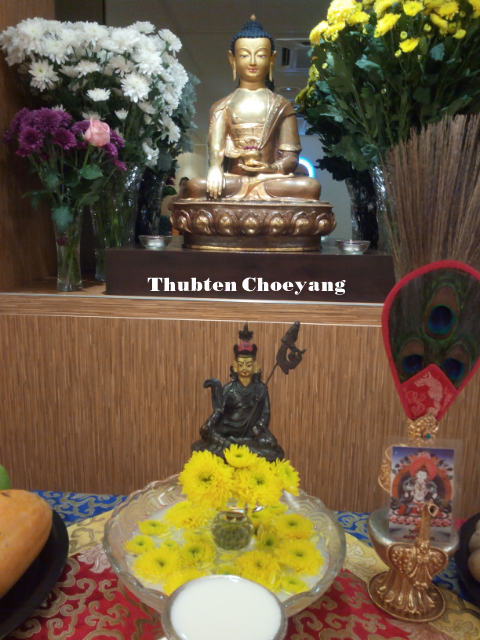The Tibetan altar for seven
water bowl offerings, the seven bowl offerings are traditionally presented on
Buddhist altar each morning, and placed in front of and a little below the
representations of the Three Jewels.
The bowls are normally made of brass, bronze or silver, are about three or four inches in diameter, and are often ornamented with auspicious designs in reposes gold or silver inlay.
Seven bowls form a straight
line from left to right. There seven bowls represent the "seven
limbed practice" for purifying negative tendencies and accumulating
merit. The Seven bowls should form a straight line from left to
right [When we are looking in or facing in direction].
The seven limbed practice
consists of the following definitions:-
- Prostrations
- Making offerings
- Confession of non-virtuous actions
- Rejoicing in the positive actions of oneself
and others
- Requesting the Buddhas to teach
- Requesting the Buddhas to remain in this world
- Dedication of merit.
The Seven bowls should form
a straight line from left to right
[When we are looking in or
facing in direction].
Before the bowls are placed
upon the altar, a little water is poured between each of the
clean bowls. As a preliminary offering this ensures that the bowls are
presented empty. The clean and stacked bowls are held in the left
hand before placement, consecration by recitation of the three syllabus, Om Ah
Hum, and the top bowl is partially filled with freshwater.
Most of the water from the top
bowl is then poured into the second bowl before it is placed upon the altar,
and this process should be repeated until all seven bowls form a straight line
from left to right.
*Note
Seven bowls form a straight line from left to right , and this is when we are looking in or facing in direction. For
The space between each bowl
should approximate to the thickness of one barley grain. If the bowls touch
each other it augers that one may become mentally dull. If they are placed too
far apart it augurs that one may become separated from one's guru.
The fresh water used to fill the offering bowl is being pouted like a barley grain from the water vessel's spout. This I indicate that the poured stream of water is thin or slow at the beginning, thick or fast in the middle, and tapers off to a narrow stream at the end. The bowls are filled to within a grain's thickness of the top of each rim.
Overflowing the rim's top is
believed to result in ethical detriment, and too low a level of water indicates
a decline in prosperity. One should not directly breathe upon the water
bowl offerings, as this creates defilement in one’s offering to the deities.
Once the offerings have been arranged they are consecrated by dipping a stem of
kusha grass or flowers into the water vessel and sprinkling the offerings,
whilst reciting the holy syllabus Om Ah Hum mantra three or seven
times.
* Note:-
Before the end of the day,
prayers, or meditation session, the seven bowls of water offerings are removed
from right to left from the altar. The water from the bowls is poured
into a receptacle and along with flowers and food offerings is scattered into a
natural environment for the benefit of animals and hungry spirits.
The seven bowls are finally
wiped clean and stacked upside down in readiness for the next morning or
meditation session. With the photo images taken from my altar will be able
to demonstrate and help to guide you for the practice.
Thank you for reading and may you find peace and with your support it helps spread the Buddha’s precious teachings and turning the Dharma wheels in the world.
Aspiration For Bodhichitta
May the precious Bodhichitta
arise
Where it has not arisen
And where it has arisen may
it not decrease
But increase further and
further
Nagarjuna's Dedication of
Merit:-
By this merit may we obtain
omniscience then.
Having defeated the enemies
wrong-doings.
May we liberate migrators
from the ocean of existence.
With its stormy waves of
birth, old age, sickness and death.
* Note
I do not own or infringe any
copyright of these pictures.
Pictures courtesy and credit
to it rightful owners.

































